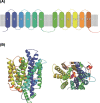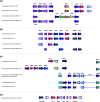Evolution and functional diversification of yeast sugar transporters
- PMID: 36928992
- PMCID: PMC10500205
- DOI: 10.1042/EBC20220233
Evolution and functional diversification of yeast sugar transporters
Abstract
While simple sugars such as monosaccharides and disaccharide are the typical carbon source for most yeasts, whether a species can grow on a particular sugar is generally a consequence of presence or absence of a suitable transporter to enable its uptake. The most common transporters that mediate sugar import in yeasts belong to the major facilitator superfamily (MFS). Some of these, for example the Saccharomyces cerevisiae Hxt proteins have been extensively studied, but detailed information on many others is sparce. In part, this is because there are many lineages of MFS transporters that are either absent from, or poorly represented in, the model S. cerevisiae, which actually has quite a restricted substrate range. It is important to address this knowledge gap to gain better understanding of the evolution of yeasts and to take advantage of sugar transporters to exploit or engineer yeasts for biotechnological applications. This article examines the full repertoire of MFS proteins in representative budding yeasts (Saccharomycotina). A comprehensive analysis of 139 putative sugar transporters retrieved from 10 complete genomes sheds new light on the diversity and evolution of this family. Using the phylogenetic lens, it is apparent that proteins have often been misassigned putative functions and this can now be corrected. It is also often seen that patterns of expansion of particular genes reflects the differential importance of transport of specific sugars (and related molecules) in different yeasts, and this knowledge also provides an improved resource for the selection or design of tailored transporters.
Keywords: Major Facilitator Superfamily; Saccharomyces cerevisiae; biotechnology; glucose transport; transport.
© 2023 The Author(s).
Conflict of interest statement
The authors declare that there are no competing interests associated with the manuscript.
Figures








Similar articles
-
Correlating sugar transporter expression and activities to identify transporters for an orphan sugar substrate.Appl Microbiol Biotechnol. 2024 Dec;108(1):83. doi: 10.1007/s00253-023-12907-4. Epub 2024 Jan 8. Appl Microbiol Biotechnol. 2024. PMID: 38189952 Free PMC article.
-
Expansion and Diversification of MFS Transporters in Kluyveromyces marxianus.Front Microbiol. 2019 Jan 10;9:3330. doi: 10.3389/fmicb.2018.03330. eCollection 2018. Front Microbiol. 2019. PMID: 30687296 Free PMC article.
-
The drug:H⁺ antiporters of family 2 (DHA2), siderophore transporters (ARN) and glutathione:H⁺ antiporters (GEX) have a common evolutionary origin in hemiascomycete yeasts.BMC Genomics. 2013 Dec 18;14:901. doi: 10.1186/1471-2164-14-901. BMC Genomics. 2013. PMID: 24345006 Free PMC article.
-
[Fructose transporter in yeasts].Postepy Biochem. 2014;60(1):94-101. Postepy Biochem. 2014. PMID: 25033548 Review. Polish.
-
Sugar and Glycerol Transport in Saccharomyces cerevisiae.Adv Exp Med Biol. 2016;892:125-168. doi: 10.1007/978-3-319-25304-6_6. Adv Exp Med Biol. 2016. PMID: 26721273 Review.
Cited by
-
Specialization Restricts the Evolutionary Paths Available to Yeast Sugar Transporters.Mol Biol Evol. 2024 Nov 1;41(11):msae228. doi: 10.1093/molbev/msae228. Mol Biol Evol. 2024. PMID: 39492761 Free PMC article.
-
Glucose receptor deletion and engineering: impact on xylose sensing and utilization in Saccharomyces cerevisiae.FEMS Yeast Res. 2025 Jan 30;25:foaf040. doi: 10.1093/femsyr/foaf040. FEMS Yeast Res. 2025. PMID: 40728911 Free PMC article.
-
Computational analysis of polymorphic residues in maltose and maltotriose transporters of a wild Saccharomyces cerevisiae strain.Open Life Sci. 2025 Apr 16;20(1):20251080. doi: 10.1515/biol-2025-1080. eCollection 2025. Open Life Sci. 2025. PMID: 40291777 Free PMC article.
-
Specialization restricts the evolutionary paths available to yeast sugar transporters.bioRxiv [Preprint]. 2024 Jul 23:2024.07.22.604696. doi: 10.1101/2024.07.22.604696. bioRxiv. 2024. Update in: Mol Biol Evol. 2024 Nov 1;41(11):msae228. doi: 10.1093/molbev/msae228. PMID: 39091816 Free PMC article. Updated. Preprint.
-
Correlating sugar transporter expression and activities to identify transporters for an orphan sugar substrate.Appl Microbiol Biotechnol. 2024 Dec;108(1):83. doi: 10.1007/s00253-023-12907-4. Epub 2024 Jan 8. Appl Microbiol Biotechnol. 2024. PMID: 38189952 Free PMC article.
References
Publication types
MeSH terms
Substances
LinkOut - more resources
Full Text Sources
Molecular Biology Databases
Miscellaneous

